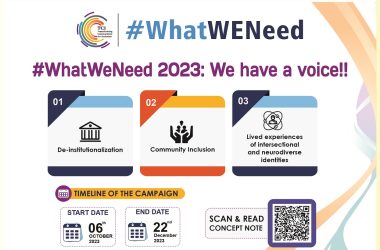This essay is the first in a three-part series on approaches and strategies in making schools safer through the varied applications of narrative practices in the school setting. You can read the second essay here and the third essay here.
Last week, I pondered this article, as I walked around the annual exhibition of some brilliant works by students of Visual Arts in the school I work at. These works were conceptualised and made by students who are between 16 and 18 years old. Many of the works had an acute sense of critique of the society we live in, of beauty standards and of education, amongst others. They brought to the surface, things adults often sweep under the carpet in our daily lives or simply accept as ‘the way it is’.
A work of art, in particular, caught my attention. This work was titled ‘Dyslexia’ by artist Prashaman Mainali. The illustration was a syringe on top and a brain at the bottom as if the syringe was being pumped into the brain. The dosage markings on the syringe were subjects and corresponding pass or fail written against them. Prashaman explained to me that it came from the idea of information being forcibly pumped into the brain, representing their experience of education.
In my 12 years of working with children and young people with disabilities and differences, it has been evident to me, that children and young people shine the spotlight on the things that are not okay with the world, things that the majority of the adult world would rather not look at, or is forced not to look at in order to simply go on with life. Children and young people just need to be offered the opportunities to show us this. The responses of many teachers to this particular work of art I mention also illustrates this. They resonated, they saw what the student was trying to say. A hard truth was made visible and it made sense.
Children and young people, when consulted, also offer possibilities for alternatives. I am constantly learning this from listening to children and young people I consult with.
Alison Gopnik, professor of psychology and affiliate professor of philosophy at U.C. Berkeley, and head of the Cognitive Development and Learning Lab explores how children learn, the creativity of the young learning brain and how it is important for us as a species. In an interview on the podcast On Being to host Krista Tippett, she speaks about how children are in a state of constant exploration. A state where “we’re released from having to think about “What do I need to do next?” And we are able to explore the range of possibilities — the range of possibilities in the world, the range of possibilities of thoughts, the range of hypothetical ways the world could be that are different from the way the world actually is. We’re able to be open to information that’s coming from lots of different sources, information that’s coming from the world all around us. And that state is the state that I think young children are in pretty much all the time.”
She goes on to speak about adolescents and their creativity in solving social problems.
She says, “The adolescents were actually the ones who were the most flexible when it came to thinking about a solution to a problem like, “Why did that person do what they did?” And I think there’s a lot of reason to believe that adolescents are often at the cutting edge of social change. And part of that is this capacity to think about all the different possibilities about the way the world could be.”
What might this knowledge make possible for us as counsellors or any adults working with children and young people?
Discourses in the school context
In the book titled ‘Narrative Counseling in schools’, authors John. M. Winsdale and Gerald. D. Monk talk about “the trend of teachers being directed to drill particular knowledge into students” as illustrated by the artwork of the student I wrote about earlier. They go on to say, “When students don’t “get it”, they are subjected to even more drilling by increases in length of the school day or in some instances, retention, in which students are made to repeat the class.”
They go on to speak about how increasingly counsellors are “being called upon to support this agenda.” They argue, “They (counsellors) are expected to be experts in the developmental pathways that young people must travel and to teach young people to follow in those paths.’ They further argue that ‘When students are viewed as receptacles to be “filled up” with guidance, all the agency rests with the counsellor, and an inadvertent pattern of passivity and disengagement can begin to be expressed by the student.”
Counsellors can thus inadvertently become tools of social control rather than social change. Their jobs can go on to enforce normativity instead of encouraging diversity.
Discourses in the school community affect all members of the school community. A discourse is a “system of statements, practices and institutional structures that share common values… By a restrictive and expressive set of codes and conventions, discourses sustain a certain world view,” writes Rachel T. Hare-Mustin in the article ‘Discourses in the mirrored room: a postmodern analysis of Therapy.’
Hare-Mustin writes that “meaning-making and control over language are important resources held by those in power.” There are all kinds of discourses about the different members of the school community. Beginning to think about the discourses that determine who is a good student, a good teacher, a good parent, a good counsellor is a good place to begin to reflect on the dominant discourses that govern the school environment. Thinking about who decides who is a good student, a good teacher, a good parent or a good counsellor, is a good way to know who holds the power. The lives of all members of the school community are influenced by these discourses that are present.
Statements like these enforce the dominance of adult narratives and subjugate young people’s experiences even when they come from young people themselves. These discourses are internalised both by adults and young people, thus trivialising at best and pathologizing at worst young people’s experiences.
Power is invisible to those who experience it
The inherent power relationship is so strong between young people and adults that it rarely even occurs to us that young people might know something that we don’t about their particular experience in this particular moment, holding within itself endless possibilities for the world.
Aryan, a young person in a conversation said to me: “Your age can’t measure or put a degree to the amount of pain you feel.”
Why did he mention age? Where might he have heard that age determined how much pain you could feel? I asked him this and he said, “A lot of people tell me you are only 16 or 17 or 18, Chya, you’re still so young, you have to go through so much more, [when you grow up].”
Statements like these enforce the dominance of adult narratives and subjugate young people’s experiences even when they come from young people themselves. These discourses are internalised both by adults and young people, thus trivialising at best and pathologizing at worst young people’s experiences.
Taking it a step further, the power relationship between adults and young people result in severe sanctions such as suspensions and dismissals, placing all responsibility on individual students rather than already existing systems in our society that perpetuate hierarchy, competition and toxic masculinity.
Children and young people possess expertise
The narrative approaches, a set of practices that influence and inform my work as a counsellor, brought home for me the idea that people, including those who are very young, possess expertise about their own lives. This strengthened what I was coming to believe in through my work with young autistic persons and children experiencing other neuro-developmental, learning or social-emotional differences. This approach also offered me a set of tools and techniques I could use in my work as a school counsellor and therapist to make visible this expertise of children and young people.
In order for this expertise of children and young people to become visible, we must offer a space where their wisdom and knowledge can show itself, where we are not positioned as experts but as ‘co-researchers’ to use the language of the narrative approaches in therapy and community work. As co-researchers, we explore a problem from a position of curiosity, inviting knowledge and possibilities of resisting the problem from the young person.
What then is our job as school counsellors?
We hold on firmly to the belief that a person experiencing a problem has the lived experience and intricate knowledge of the problem as well as ways in which they can and are resisting the problem, even when we are talking about children and young people. Working from this perspective would mean that instead of teaching children ways to respond to problems, we look to them to learn how they are responding to problems in their own lives. We consult them about their knowledge of the problems they are facing and their know-how of resisting its influence in their lives to uncover the possibilities this presents for further resisting the problem.
“You may give them your love but not your thoughts,
For they have their own thoughts.
You may house their bodies but not their souls,
For their souls dwell in the house of tomorrow,
which you cannot visit, not even in your dreams.
You may strive to be like them,
but seek not to make them like you.
For life goes not backward nor tarries with yesterday.”
Kahlil Gibran’s wisdom on children
‘Our lives are multistoried!’ – this belief has been reinforced for me through the narrative approaches. Our job is excavating and rescuing alternative stories, many stories, stories we previously did not know, resisting the dominant discourses and asking for stories that are possible to know if we ask and listen with true curiosity, a curiosity with faith in the yet unknown possibilities that could emerge.
Prathama Raghavan is a developmental psychologist with a PhD from Université Paul-Valéry, Montpellier, France. She currently works as a school counsellor, Mental Health and Disability Support worker in Kathmandu, Nepal. Her work is informed by feminism, disability justice, neurodiversity, narrative approaches and poetry. She has recently become interested in working towards building ‘imperfect solidarities’ through group conversations in a far from perfect world.



